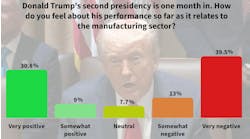U.S. Ranks #8 In Global Innovation Index
Among 110 countries, the U.S ranked eighth in innovation leadership. Singapore topped the list, followed by South Korea and Switzerland according to the BCG/NAM/MI International Innovation Index.
The report was produced jointly by The Boston Consulting Group (BCG), the National Association of Manufacturers (NAM), and The Manufacturing Institute (MI). The index is part of a broad research study that looked at both the business outcomes of innovation and governments ability to encourage and support innovation through public policy. The study comprised a survey of more than 1,000 senior executives from NAM member companies across all industries; in-depth interviews with 30 of the executives; and a comparison of the "innovation friendliness" of 110 countries and all 50 U.S. states.
"America needs a bold innovation strategy," said NAM President John Engler. "U.S. manufacturing innovation leadership is at risk. We've fallen behind countries in East Asia and Europe. America can not afford to lose its manufacturing innovation edge and the wealth and jobs that it generates throughout our economy. Government can help move America up the innovation index by enacting more competitive tax, trade and workforce policies that enable U.S. manufacturers to innovate and succeed globally. The report also shows the U.S. needs more competitive immigration and infrastructure policies to help drive innovation," he said.
To rank the countries and states, the study measured both innovation inputs and outputs. Innovation inputs included government and fiscal policy, education policy and the innovation environment. Outputs included patents, technology transfer, and other R&D results; business performance, such as labor productivity and total shareholder returns; and the impact of innovation on business migration and economic growth.
"The emergence of challengers from rapidly developing economies such as India and China has transformed the playing field. With high-quality, inexpensive products flooding the market from every corner of the globe, competing on cost alone is a losing battle for most U.S.-based manufacturers," said co-author James P. Andrew, a BCG senior partner.
Six states scored above average in both their innovation policy environment and performance: California, Connecticut, Delaware, Massachusetts, New York and Washington. Overall, however, the study found the states are quite similar with respect to innovation. The key reasons are that federal policy is the same across all states, and the U.S. has an "American culture" that affects the overall business climate, overriding the wide variety of geographies, industries and demographics.
The report names four critical factors that lead to innovation success -- idea generation, structured processes, leadership and skilled workers -- and stresses that government must support these efforts through effective policies.
"A skilled, educated workforce is the most critical element of innovation success -- and the hardest asset to acquire," added co-author Emily Stover DeRocco, president of The Manufacturing Institute. "The study shows that in companies and countries alike, a high number of researchers and advanced degrees -- particularly in science and engineering -- are the greatest predictor of success. Innovation requires capable and skilled people at every level -- from the factory floor to the top floor."
The report also suggests six concrete actions that states and countries can take to help drive forward innovation in manufacturing:
- Strengthen the workforce;
- Maintain a strong manufacturing base;
- Lead by example;
- Make innovation easier;
- Improve the payback; and
- Be consistent with policies.
The findings are published in a new report titled "The Innovation Imperative in Manufacturing: How the United States Can Restore Its Edge," available at www.nam.org/innovationreport.



